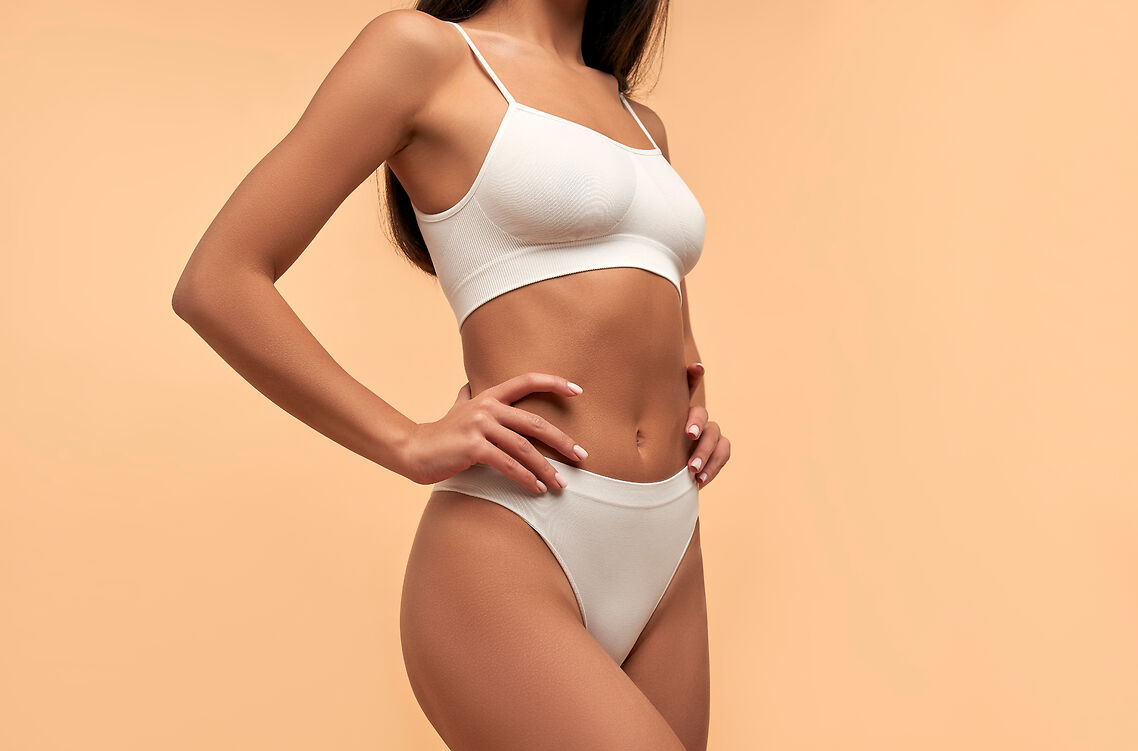 Photo Credit: Courtesy of ORION PRODUCTION/Shutterstock
Photo Credit: Courtesy of ORION PRODUCTION/Shutterstock
Iulianna C Taritsa, BA; Kirsten A. Schuster, MD, JD; Samuel Lin, MD, FACS
AirSculpt is a modified version of liposuction for fat removal and body contouring. It is FDA-approved and designed to be minimally invasive and gentler to the surrounding tissue than traditional liposuction. The technique and its proprietary equipment have been developed. There are several clinics where AirSculpt is available.
A traditional liposuction procedure uses a large cannula to break up excess fat before removal (Dixit et al). In comparison, the AirSculpt device uses a thinner vibrating cannula to break up and remove fat. AirSculpt is used for areas of higher fat deposition that the patient would like removed or distributed elsewhere. Typically, these are areas like the hips, abdomen, arms, thighs/legs, tailbone area and back, lower neck, and under the chin. There is also the option to use the AirSculpt in the pubic area. The only area where the AirSculpt is not used is the region above the chin, due to the higher concentration of nerves in the area (Seneviratne et al). The fat removed by the AirSculpt device can be redistributed to other areas of the body if the patient would like, thus it is often combined with other plastic surgery procedures such as gluteal, breast, and hip augmentation procedures.
The results of AirSculpt are much like the results after a traditional liposuction. Patients can expect a modest amount of fat removed during the procedure, with the result being a contoured form in the area where AirSculpt is used. The final results of the contouring can be seen within 6-12 weeks (about 3-6 months) after the procedure when the swelling has subsided, and new collagen has formed. It is crucial to speak to your surgeon about your goals and expectations for the surgery, as well as their input regarding what can realistically be achieved with the procedure. Results are lasting, though it is recommended to keep a healthy diet and regular exercise plan to minimize post-procedural weight gain, which can cause contour irregularities (Ferry et al). AirSculpt clinics might also advertise that the vibrations of the cannula create frictional heat during the procedure that may help with skin looking mildly tighter afterward. The amount of skin tightening is likely not enough to treat very deep wrinkles or high degrees of sagging skin. Your clinic may offer AirSculpt paired with a skin tightening procedure. Ask your clinic about your options if this is of interest.
The AirSculpt procedure is best for adults who would like to get rid of stubborn areas of fat that have been resistant to loss from diet and exercise. The procedure is not intended for weight loss but is best for patients who would like to target and contour specific aspects of their bodies. All patients will undergo a medical screening by their surgeon before the procedure to ensure they are medically cleared. While there are no absolute contraindications for the AirSculpt procedure, some lifestyle habits, such as smoking, may prolong the healing process (Almutairi et al).
The total procedure time can vary depending on the targeted area, the number of areas treated, and the amount of fat being removed. Most patients can expect their AirSculpt procedure to last between forty-five minutes to four hours. The recovery time is typically one to two days, depending on the procedures completed. Patients should be walking the same night as the procedure and continue walking and exercising as normal every day after the procedure during the recovery period. It is recommended that patients wear a compression garment for two weeks from the time of the procedure to minimize swelling, and then only at night for the third week.
Because the tool used is smaller than the traditional liposuction cannula, stated potential benefits include less bruising with AirSculpt though you may still experience minimal bruising or swelling afterward. Also, where the tool enters/exits, you may be left with small red spots that resemble blemishes or freckles. These spots are around 2 millimeters in diameter (about the same size as the tip of a sharpened pencil) and should fade with time. Unlike liposuction, full recovery is typically expected in several weeks, rather than several months. With any invasive procedure, there is a small risk of infection and a risk for scarring (Morandi et al). No anesthesia is required for AirSculpt, thus no anesthesia-related side effects are implicated. Some patients have reported dissatisfaction with lumps or irregularities in contouring long-term if they regain weight after the procedure.
AirSculpt is more expensive than traditional liposuction procedures. The reported cost of the procedure is between $5,000 to $24,000, with an average of around $13,000. Actual costs generally depend on the number of areas being treated and the amount of fat that is expected to be removed. These estimates do not include concomitant fat transfer (e.g. breast augmentation).
Patients report the procedure to be relatively pain-free. The procedure is gentle enough to be done without general anesthesia, with an option for local anesthesia if needed. While general anesthesia is not used, an oral relaxing medication is an option for patients who would like a relaxant for the procedure. Sometimes nitrous oxide can be offered as well. After the procedure is over, patients report faster recovery times than liposuction and can resume normal activities relatively quickly due to the minimal amount of trauma to surrounding tissue caused by the AirSculpt procedure.
References
Almutairi K, Gusenoff JA, Rubin JP. Body contouring. Plast Reconstr Surg 2016; 137(3):586e–602e. doi:10.1097/PRS.0000000000002140.
Dixit VV, Wagh MS. Unfavourable outcomes of liposuction and their management. Indian J Plast Surg. 2013 May;46(2):377-92. doi: 10.4103/0970-0358.118617. PMID: 24501474; PMCID: PMC3901919.
Ferry AM, Chamata E, Dibbs RP, Rappaport NH. Avoidance and Correction of Deformities in Body Contouring. Semin Plast Surg. 2021 May;35(2):110-118. doi: 10.1055/s-0041-1727207. Epub 2021 Jun 8. PMID: 34121946; PMCID: PMC8186988.
Morandi EM, Ploner C, Wolfram D, Tasch C, Dostal L, Ortner F, Pierer G, Verstappen R. Risk factors and complications after body-contouring surgery and the amount of stromal vascular fraction cells found in subcutaneous tissue. Int Wound J. 2019 Dec;16(6):1545-1552. doi: 10.1111/iwj.13245. Epub 2019 Oct 13. PMID: 31606947; PMCID: PMC7949374.
Seneviratne SO, Patel BC. Facial Nerve Anatomy and Clinical Applications. 2023 May 23. In: StatPearls [Internet]. Treasure Island (FL): StatPearls Publishing; 2023 Jan–. PMID: 32119456.
For more information, visit Dr. Brian A. Levine's social media:

























